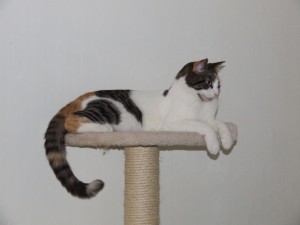Tweak, tweak, tweak!
 One of the many advantages to feeding a home-prepared ground or prey model diet (see A Prey Model / Whole Prey Feeding Guide) is the ability to customize the menu to suit your cat’s needs.
One of the many advantages to feeding a home-prepared ground or prey model diet (see A Prey Model / Whole Prey Feeding Guide) is the ability to customize the menu to suit your cat’s needs.
Like so many of us, I have a multi-cat household – three older siblings (Allen, Rachel and Meghan), two younger siblings (Spencer and Heather), and one middle child (Ralph). Cats, like people, are individuals with their own particular preferences and problems; catering to these preferences and addressing specific problems can be interesting, to say the least.
Shortly after Spencer’s adoption and integration into my clowder, it became obvious he was a gulper and a glutton. Many cats will self-regulate, but there are some that seem born with a bottomless pit for a tummy and a vacuum for a mouth. These cats can scarf their meals down in an eye blink and are always on the lookout for more. Spencer would, in fact, clean all six cats’ plates and mine, too, given half a chance.
Slowing him down is easy. When I prepare their meals, I cut very large pieces for my little glutton. Everyone else gets two good size pieces of meat to gnaw on, but Spencer gets one large chunk he has to work hard to cut down. By the time he’s finished, everyone else is, too. Tweak!
While transitioning my cats to raw (Taking the Plunge!), I noticed Rachel was more easily discouraged by tough meat and bones than her housemates. The slicing, tearing, and scissoring actions required to cut through meat and tendons and break down bones are very important to dental health, so this was a concern to me. To help her gain the confidence she needed to deal with these meals, I cut her tougher meats, like beef round pieces and chicken gizzards, into smaller pieces and used kitchen shears to pre-break the bones in her bone-in meals. Today, Rachel can handle any size meat chunks and requires no help in polishing off her bone-in meals. Tweak!
Not too long after that, I realized Allen needed a little more bone in his diet in comparison to the other cats to keep his digestive system regular. Easy tweak! One extra chicken wing piece per bone-in meal.
A month later, I increased my cats’ organ meals from two to four servings a week and cut the serving sizes in half. This eliminated the soft stools I was occasionally still seeing and reduced the likelihood of organ-rich upset tummies, something I had only seen once or twice, but wanted to avoid completely. Tweak!
Got an overweight cat? Skin your chicken, turkey, and other bird-related products before feeding. Got a skinny cat? Give him some of the skin from your other cat’s meal! You can do the same for cats with metabolisms that run in either direction – reduce or increase the fat content, without over- or under-feeding any other ingredient. All of my cats are at a healthy weight, but Meghan has a slow metabolism and routinely gets less fat and skin than the other cats, while Rachel has a faster metabolism, and can be a picky eater, so she gets more fat to keep the weight on as well as feed her energy levels.
Many diseases have nutrition-related components. If your cat becomes ill with one of these and you’re feeding a commercial diet, you can’t adjust the food to address the issue; instead, you have to find an alternative food product and hope your cat will eat it. If you’re feeding a home-prepared diet, however, not only is the likelihood of such an illness occurring immeasurably reduced, but addressing it becomes much easier since you can control every item on your cat’s menu independent of any other item.
Allergies and intolerance to ingredients are frequent occurrences with commercial-fed cats. They can cause vomiting and diarrhea, among other issues, and can lead to irritable bowel disease (IBD). Identifying the culprit ingredient is often very difficult because commercial products contain so many ingredients and additives and not all of them have to be listed on the label. Switching a cat to a home-prepared raw diet allows the owner to enormously simplify the cat’s diet – granting the cat’s digestive system time to recuperate – and then carefully control the addition of new ingredients as the cat’s health improves. Foods that cause problems are easily and quickly identified and removed from the menu.
Home-preparing your cat’s raw food allows you total control over the quality and wholesomeness of the meats and other ingredients that make up those meals, and gives you a flexibility you can’t get with commercially-prepared products. Slowing down aggressive eaters, addressing various metabolic rates and accounting for different digestive sensitivities are just a few of the ways you can tweak these diets to suit your cat’s very special purrsonality.
If you enjoyed this post or found it informative, please “Like” it, “Tweet” it, or share it using any of the buttons below. And don’t forget to check out our FB page, join the discussions in our awesome FB group and follow us on Twitter!


Comments
Tweak, tweak, tweak! — No Comments